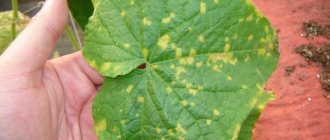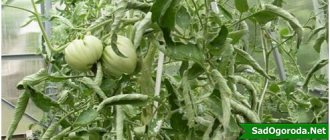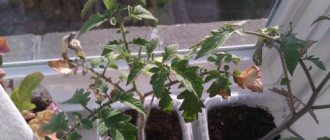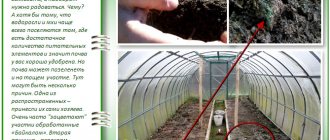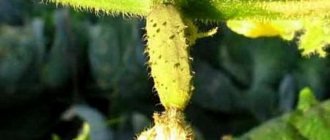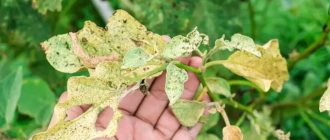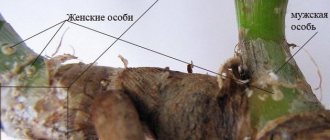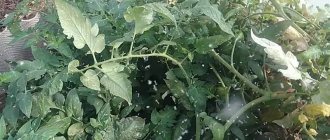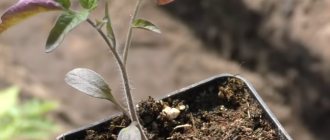Sometimes yellow ovaries appear on cucumbers in a greenhouse, which fall off over time. This phenomenon is especially unpleasant at the beginning of summer, when you already want to pick the first cucumber from your garden. But they are still missing... This situation is fixable.
The question of why eggplant leaves turn yellow has already been discussed. Many factors are very similar for greenhouse plants.
The main reasons for the color change in young fruits and their falling off are associated with greenhouse conditions (air and soil temperature, watering, fertilizing, bush formation).
If you notice that the ovaries on cucumbers have begun to turn yellow and fly off, you need to first find out why this is happening. Then take all necessary measures to correct the problem. What to do in this situation?
Zelentsy started on a too young plant
The reason for yellowing and drying of the ovary of cucumbers is often the young age of the plants. Such bushes do not yet have time to form a sufficiently strong leaf apparatus that will fully nourish the ovary, so young plants are forced to get rid of it, since they themselves are not yet strong enough.
While the cucumbers are growing and forming, it is necessary to remove all the flowers, since they will not produce full-fledged greens anyway.
Diseases
Leaf blades may change color due to disease. Most often, cucumbers suffer from fusarium and pythiosis. These are fungal infections characterized by darkening and subsequently yellowing of foliage.
As a rule, the fungus appears after a sharp change in temperature, therefore, for the purpose of prevention, it is recommended to treat the seedlings with Fitosporin.
Interesting! Astilbe flower - planting and care
Violation of the optimal temperature regime of air and soil
Cucumber ovaries turn yellow and dry out from too high or low temperatures in greenhouse air or soil, or from sudden temperature changes over a short period of time. Plants suffer greatly when it gets cold during the day and especially at night, since their ovaries grow at night. Under such conditions, the root system of cucumbers does not develop, or this process goes poorly and may even begin to die. In cold soil, healthy roots lose their ability to normally absorb nitrogen from the soil, and the ovaries lack the essential nutrient they need.
There is an ideal temperature that must be maintained in order for cucumbers to grow and develop normally. Before fruiting it is:
- 22-24 °C – in clear weather;
- 20-22 °C – in cloudy weather;
- 17-18 °C – at night.
When the cucumbers begin to bear fruit, the temperature needs to be increased slightly:
- 23-26 °C – in clear weather;
- 21-23 °C – in cloudy weather;
- 18-20 °C – at night.
For varieties pollinated by bees, all temperature indicators should be 1-3°C higher.
The maximum temperature that cucumber plants tolerate well is up to 36 °C, the minimum is 13-15 °C. Temperature conditions above and below these limits have a negative effect on vegetating cucumbers; they either overheat or become overcooled. All this has the most negative effect on the growth and development of the ovaries; they begin to turn yellow.
Sudden temperature changes most often occur in greenhouses. During the day, the air and soil in them become very hot due to the fact that excess heat cannot escape, and at night they cool sharply. No crop welcomes such temperature changes, but cucumbers are most sensitive to them.
Measures to combat overheating of plants include:
- ventilation of greenhouses in hot weather;
- whitening the walls and roofs of shelters with chalk;
- shading plants with white reed shields or mats;
- abundant watering in the evening;
- mulching the soil under cucumbers with hay, straw, fresh sawdust, black film or agrofibre of the same color.
To avoid a drop in temperature at night, low greenhouses are covered with another layer of film and dark-colored containers filled with water are placed in them. During the daytime, the liquid will heat up and accumulate heat, and at night, it will release it into the air space. In large greenhouses, if electricity is supplied to them, electric or infrared heaters are installed. Stoves that burn wood, sawdust and pellets, for example, such as Buleryan, are excellent for heating such structures.
Nutrient deficiencies or imbalances
Often the reason that cucumber ovaries turn yellow and do not grow is insufficient nutrition, that is, a lack of basic elements and microelements in the soil.
This picture can be observed when plants have exhausted the supply of nutrients in the soil, and there are no additional feedings. Varieties and hybrids with a bunched ovary type suffer especially from insufficient nutrition. In this case, it often turns out that 1-2 cucumbers grow, and the rest wither. Cucumber embryos can also turn yellow due to an excess of nutrients or improper application of fertilizers without observing the required proportions.
When the flowering phase begins, cucumbers need phosphorus, and during fruiting - nitrogen and potassium, so you can save the bushes and the harvest if:
- reduce or stop feeding with fresh manure;
- replace it with wood ash (300 g per 1 m2 of planting area);
- feed them with solutions of complex fertilizers: Kristalon, Master, Mortar, Kemira, Agricola, etc.
Such fertilizing is needed both for greenhouse cucumbers and for those growing in open beds, but they are especially relevant for plants planted in closed ground, since in such conditions the need for nutrition is greater.
We recommend reading
Causes of yellowing leaves in cucumbers and what to do
What to do if the leaves of cucumber seedlings turn yellow and dry
Methods for controlling cucumber pests in greenhouses and open ground
Symptoms of cucumber diseases and methods of combating them
What to do: the best folk remedies
As soon as you notice that the flowers on the cucumber vines turn yellow and fly off, you need to try to understand why this is happening. Having found the cause of the problem, you can eliminate it and thereby save the harvest.
Trimming and pinching
If an excessively large number of stepsons have formed on the bush, then it is recommended to cut off all the lower shoots up to the fifth leaf blade. On the remaining stepsons you need to cut off the leaf plates, leaving only two of them.
If there is rapid growth of the lashes, then they will need to be pinched at the tops. Immediately after this, active growth of lateral shoots will begin, and a large number of female flowers will form on them
Top dressing
If there is a lack of nutrients, the plants should be fed as soon as possible on the foliage with a solution of one of the following products: Ammofoska, Potassium Sulfate, Diammofoska or Nitrophoska. When preparing the solution, strictly follow the manufacturer's instructions.
For foliar feeding, you can use the following solution: 10 liters of water, one tablespoon of urea and three tablespoons of wood ash. Treatment is carried out in the evening at sunset.
If the soil is saturated with nitrogen, then the bushes experience intensive growth of greenery, while very few ovaries are formed. To correct the situation, the bushes are watered with a superphosphate solution.
To prepare it, combine 3 liters of just boiled water with twenty tablespoons of superphosphate. Mix everything well and refrigerate for 24 hours, but do not forget to shake the mixture regularly. To prepare the working solution, pour a couple of tablespoons of the mixture into 10 liters of water.
Drying the soil
If the soil in the garden bed is waterlogged, then even wildly flowering cucumber bushes do not form ovaries. In this case, it is recommended not to water the plants for several days until their foliage begins to wither. In this stressful situation, the bushes begin to actively produce a large number of female flowers.
Dropping
If the shoots rot, the roots will not be able to deliver the required amount of nutrients to the flowers, which will cause them to fly around en masse.
In this case, the lower part of the stem is bent to the soil surface and covered with a layer of earth, and the affected area is removed. After a while, roots will grow on the shoot, but until this happens, it is better to cut off most of the ovaries. It is also recommended to feed the stems with complex mineral fertilizer.
Pest treatment
If the abscission is due to the fact that pests have settled on the plant, then it is recommended to spray it with one of the following folk remedies:
- 3 tablespoons of ammonia are dissolved in 10 liters of water;
- 1 liter of water add a quarter of a piece of grated laundry soap and 1 tablespoon of baking soda;
- infusion of onion peel;
- a mixture of potassium chloride and superphosphate (1:2);
- add 0.3 kg of wood ash to a couple of liters of water, boil the mixture for half an hour, and then dilute it with 1 bucket of water.
If the bushes have not yet begun to bear fruit, they can be treated with one of the pesticides: Commander, Aktara or Alatar. The following drugs are more harmless: Fitoverm, Biotlin and Kleschevit.
Improper watering - excess or lack of moisture
Cucumbers, as humid tropical plants, are very partial to moisture, but in order for them to grow and bear fruit, they need to be watered correctly. Before fruiting begins, watering should be moderate, and with its beginning - more abundant. The optimal frequency of watering is every 1-2 days, in hot weather - daily (or even 2 times a day - morning and evening). In general, you need to look at the condition of the soil - if it is dry, you definitely need to water the beds. If the ground is wet, you can skip the next watering. The main thing is to maintain a balance, since a lack and excess of liquid in the soil is equally unfavorable and can lead to yellowing of the ovaries.
Water for watering this crop in a greenhouse must be free of chlorine and warm (23-25°C); cold water is not allowed (such liquid causes temperature stress to the roots, which ultimately affects the condition of the entire plant, including the ovary).
The best time for such events is evening or early morning. There is no need to do this during the day: the water will quickly evaporate, this will only increase the air humidity, while the plants themselves will be able to receive moisture in a minimal amount.
Insufficient air humidity
Dry air is another reason for the yellowing of cucumber ovaries. These plants have an increased need for high relative air humidity (85-95%). If this indicator is lower in the greenhouse, transpiration will be more intense, so the absorption of moisture from the soil by cucumbers will also increase. If there is not enough of it in the soil, the leaves and ovaries will begin to wither and the flowers will fall off.
The necessary measures to prevent yellowing of the ovary are to irrigate the soil between the rows (but not the plants themselves). Water evaporating from the ground will increase the air humidity in a closed greenhouse.
Preventive measures
To prevent yellowing of the ovary in the greenhouse, preventive measures should be followed:
- choose a variety suitable specifically for greenhouse cultivation;
- organize a place for planting cucumbers;
- pre-fertilize the planting site;
- carry out preventive spraying with a 1% solution of boric acid;
- observe the irrigation regime, use warm water;
- Regularly prune bushes and remove excess ovaries;
- monitor weather conditions and ensure optimal temperature in the greenhouse;
- harvest in a timely manner.
Thickened plantings
Cucumbers need a lot of light for normal growth and fruiting. Despite the fact that the beds for growing them and the greenhouses are always located in a sunny place, the plants themselves can shade each other. This happens if the seeds or seedlings were planted too densely.
At the initial stage of development, a small area is enough for plants. But with the growth of the bushes and the increase in green mass, the fruits find themselves in dense shade, which provokes yellowing of the ovaries and their subsequent falling off. Bee-pollinated varieties and hybrids throw out barren flowers, delaying fruiting.
Correct placement of plants can correct the situation. When choosing planting schemes and calculating the number of cucumber bushes per 1 m2, it is worth considering:
- sizes of beds in greenhouses and on the ground;
- design of shelters and trellises;
- whether the cucumbers being grown belong to one or another variety or hybrid;
- the degree of climbing of the plant;
- method of forming a bush;
- timing and place of cultivation.
On average, 3 to 6 cucumbers are placed per 1 m2. A gardener can obtain basic recommendations regarding the selected variety or hybrid from the manufacturer’s instructions on the seed packet. They must be adhered to in order to prevent thickening of the plantings and yellowing of the fruits.
Reviews from experienced gardeners
- In order for the ovaries to develop normally, it is necessary to promptly remove fruits from the bushes that have reached the required weight indicated on the packages of seeds. Before planting seeds, you should read the supplier’s recommendations for growing a particular species and do not forget that it is better to plant exactly those cucumbers in the greenhouse that the manufacturer recommends.
- In cold weather, cucumbers need to be supported with foliar feeding. You can use double superphosphate - 4 tbsp. you need to pour 2-3 liters of boiling water (it will not dissolve in cold water), stir well, and let it brew for at least a day. Then increase the volume of water to 10 liters and spray the cucumber bushes leaf by leaf using a fine spray sprayer.
Natalia
Author
Ask a Question
The situation with yellowing and falling of ovaries from cucumber vines can always be corrected. The hard work of vegetable growers should be rewarded if everything is done for this - the greenhouse is built, the seeds are sown, the plants are watered and fed. And then the harvest will delight you with its abundance! Health to you and your loved ones!
The bush grows without formation
In a greenhouse, one of the reasons why cucumber ovaries turn yellow is the lack of formation of the bushes. On the ground, this problem manifests itself less, when walking and here, when growing crops vertically, the bushes need to be looked after.
Most varieties and hybrids intended for cultivation in greenhouses intensively increase green mass. This is facilitated by a special microclimate, as well as enhanced nutrition of the plantings. While the bushes are occupied with leaves and shoots, they do not bear fruit. In addition, greens also suffer greatly from shading.
Shaping the plants will help speed up the ripening process. It consists in removing the first ovaries, side shoots and leaves from the cucumber, forming a so-called blind zone at the bottom. Depending on the timing of cultivation and the characteristics of the variety or hybrid, it may vary. On average, from 3 to 8 first nodes are subject to blinding.
Next, the side shoots of the cucumbers are pinched as they grow and old and excess leaves are cut off. The mustache is removed, on which the plant also consumes a lot of nutrition. Follow the recommended schemes:
- for specific conditions (heated or unheated, high and low greenhouses);
- growing time (early spring, spring-summer, autumn-winter);
- type of cucumbers (bee-pollinated, parthenocarpic);
- growing location (open or closed ground).
When using molding, the fruits receive enough nutrients and light and do not turn yellow.
Nutrition
A lack or excess of certain minerals at certain times of the year directly affects the health, shape and taste of the ripening cucumber fruit. Do not apply fertilizers without instructions, so as not to lose most of the crop.
What to do to ensure that cucumbers have enough nutrients throughout the season:
- When planting, water the bushes with mullein solution. This will provide the supply of nitrogen necessary for growing strong green mass.
- When the cucumbers bloom, support them with potassium fertilizer. Both watering and leaf spraying are appropriate.
- With the appearance of ovaries, plants need potassium and phosphorus, as well as trace elements.
- Ripe fruits must be removed so that they do not take away nutrients from the new ovaries.
Cucumbers will be uncomfortable in obviously poor soil. Be sure to dig up the soil and add organic matter.
Pollination problems
When growing insect-pollinated varieties and hybrids, the reason that the ovary turns yellow and falls off may be that there is insufficient fertilization of the female flowers. Risk factors include:
- weather;
- early or late cultivation;
- improper microclimate in the greenhouse;
- absence of plants with a pronounced male type of flowering.
Bees, which are the main pollinators for cucumbers, do not fly in rain, cloudy and cold weather. They also do not show much interest in hot greenhouses and greenhouses, so they need to be attracted there. For insects to do their job, it is worth opening the windows and doors. Spraying the plants with a solution of water and honey and boric acid will help.
If there are no bees, the gardener will have to work for them. To prevent cucumbers from turning yellow, hand pollination is used. Work is carried out in the morning when the female flower is blooming, in warm and dry weather. Use a soft brush or male flower stalks.
Growing several varieties or hybrids of cucumbers in a greenhouse also helps to increase the number of fertilized ovaries. If the main crop is a plant with a predominantly female type of flowering, it is worth planting bushes that consistently form male inflorescences. They will act as good pollinators for green plants. Usually, to solve the problem of yellowing of cucumber ovaries in a greenhouse, the presence of 10% of such plants is sufficient.
Biological factor
Diseases
The ovaries may turn yellow and fall off if the plant becomes infected with some disease. Usually, if not only the ovaries, but also the leaves turn yellow and fall off, the cause is bacteriosis.
Bacteriosis is one of the most common cucumber diseases, which significantly reduces yield. The symptoms of the disease are as follows:
- At first, small spots or droplets of liquid appear on the leaves;
- Over time, they turn black and dry out, and the tissue around the lesion begins to dry out;
- after 2-3 days, the lesion spreads to the entire leaf, it turns yellow, wrinkles and falls off.
Rice. 12 – Bacteriosis. Most common disease
The fight against bacteriosis consists of two stages: removal of damaged parts of the plant and preventive treatment of the remaining, unaffected parts. After removing the affected leaves, ovaries and flowers, the cut sites must be treated with a 0.2% solution of potassium permanganate.
The remaining parts of the plant and its neighbors should be sprayed with a mixture of the following composition:
- Bordeaux mixture – 100 g;
- copper chloroxide – 40 g.
- water – 10 l.
Another, no less dangerous disease of cucumbers that leads to yellowing of the ovaries is powdery mildew . This fungal disease has the same symptoms in all plants, consisting in the appearance of small “webs” distributed over some part of the plant. Over time, the cobwebs turn black, and in their place the plant develops ulcers.
Rice. 13 – Powdery mildew on cucumber leaves
Usually, when affected by powdery mildew, as with any fungal disease, the plant stops flowering and fruiting. If the disease is in an early phase, or it cannot completely overcome the plant’s protective barriers, then the effect of the disease will be, although not so harmful, but still unpleasant. The fruits will become significantly smaller, they will become more faded and curled.
Powdery mildew is controlled using almost any fungicide with the obligatory removal of the affected parts of the plant.
Pests
Pests can also affect the formation of ovaries. This is not surprising, since by feeding on plant juices, they disrupt its nutrition and natural metabolic processes. In this case, as in the case of diseases, not only yellowing or wilting of the ovaries is possible, but also a complete cessation of fruiting.
Rice. 14 – Typical pests on seedlings – thrips or aphids
Most often, cucumbers are attacked by aphids . Typically, aphids appear on cucumbers at the end of June. These are small insects, up to 1.5 mm long, usually green or yellow. Usually, they appear together with ants, with whom they live in symbiosis.
Despite their small size, due to their numbers, aphids are capable of destroying any plant in the shortest possible time. Therefore, you should not put off the destruction of these pests for a long time. The optimal remedy against aphids is acaricidal type insecticides. As a folk remedy, you can use a solution of soap and copper sulfate in water (10-30 g of copper sulfate is dissolved in 1 liter of water and 20 g of liquid soap is added). This mixture is applied directly to areas of the plant affected by aphids.
Another common pest of cucumbers is the spider mite. Its activity also has a significant impact on fruiting. The tick is a small bug about 1 mm in size, red or yellow.
Rice. 15 – Spider mite
Acaricides (for example, Mite, Ortus and others) should also be used against this pest.
Too many ovaries
Small cucumbers also turn yellow if the fruit load on the bush is too high. Then the plant itself regulates the number of fruits it can grow. Isolated cases are not the reason for intervention on the part of the gardener. Measures to save the crop should be taken only when cucumbers shed their ovaries en masse.
The main reasons for such sabotage are:
- insufficient nutrition of bushes;
- incorrect formation;
- bunch type of fruiting plants.
High-quality soil preparation, regular fertilizing, the use of optimal formation schemes, and removal of part of the ovaries will help correct the situation so that the remaining green plants can receive sufficient nutrition and grow.
